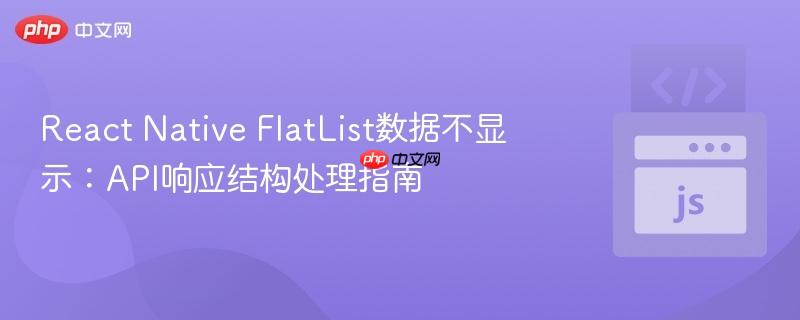
在react native应用中,flatlist 是一个高性能的列表组件,常用于展示大量滚动数据。它通过虚拟化技术优化了性能,只渲染屏幕上可见的列表项。然而,要让 flatlist 正常工作,关键在于为其提供正确格式的数据,并确保数据在组件的生命周期中被有效管理。
一个常见的场景是从远程API获取数据并填充 FlatList。这通常涉及以下步骤:
许多开发者在初次使用 FlatList 时,可能会遇到数据已获取但列表仍为空白的问题。这通常不是网络请求失败,而是对API响应的结构理解有误,导致 FlatList 接收到的数据不是其期望的数组格式。
考虑一个典型的API响应,例如来自 https://dummyjson.com/products 的数据。该API返回的JSON结构如下:
{
"products": [
{
"id": 1,
"title": "iPhone 9",
"description": "An apple mobile which is nothing like apple",
// ...更多产品属性
},
// ...更多产品对象
],
"total": 100,
"skip": 0,
"limit": 30
}从上述结构可以看出,实际的产品列表数据嵌套在名为 products 的键下。如果直接将整个 responseJson 对象赋值给 FlatList 的 data 属性,或者存储到组件状态中,FlatList 将无法正确识别并渲染数据,因为它期望的是一个纯粹的数组。
要解决 FlatList 不显示数据的问题,核心在于确保从API响应中提取出正确的数组部分。在 ShopList 组件中,当 fetch 请求成功并返回 responseJson 后,我们需要访问 responseJson.products 来获取实际的产品数组。
以下是 ShopList 组件中 fetchItem 方法的修正代码:
import React, { Component } from 'react';
import { View, FlatList, Image, Text, StyleSheet } from 'react-native';
// 假设 ShopListRow 路径正确
import ShopListRow from './ShopListRow'; // 根据实际路径调整
export default class ShopList extends Component {
constructor(props) {
super(props);
this.state = {
shops: [], // 初始化为空数组
loading: true, // 添加加载状态
error: null, // 添加错误状态
};
}
componentDidMount() {
this.fetchItem();
}
fetchItem = () => { // 使用箭头函数确保this绑定
this.setState({ loading: true, error: null }); // 开始加载前重置状态
fetch(`https://dummyjson.com/products`, {
method: 'GET',
})
.then(response => {
if (!response.ok) { // 检查HTTP响应状态
throw new Error(`HTTP error! status: ${response.status}`);
}
return response.json();
})
.then(responseJson => {
// 关键修正:从responseJson中提取products数组
this.setState({ shops: responseJson.products, loading: false });
// console.warn('Fetched shops:', this.state.shops); // 调试用
})
.catch(error => {
console.error("Error fetching data:", error);
this.setState({ error: error.message, loading: false });
alert(`数据加载失败: ${error.message}`); // 用户友好提示
});
};
render() {
const { shops, loading, error } = this.state;
if (loading) {
return (
<View style={styles.centeredView}>
<Text>正在加载数据...</Text>
</View>
);
}
if (error) {
return (
<View style={styles.centeredView}>
<Text style={styles.errorText}>加载失败: {error}</Text>
</View>
);
}
return (
<View style={styles.container}>
<FlatList
data={shops}
renderItem={({ item, index }) => (
<ShopListRow
shop={item}
index={index}
/>
)}
keyExtractor={item => String(item.id)} // 确保key是字符串类型
initialNumToRender={10} // 优化初始渲染数量
// extraData={this.state} // 通常不需要,除非renderItem依赖extraData以外的state
/>
</View>
);
}
}
const styles = StyleSheet.create({
container: {
flex: 1,
backgroundColor: '#FFFFFF',
},
centeredView: {
flex: 1,
justifyContent: 'center',
alignItems: 'center',
backgroundColor: '#FFFFFF',
},
errorText: {
color: 'red',
fontSize: 16,
},
});在上述修正中,this.setState({shops: responseJson.products}) 是核心改动,它确保了 FlatList 的 data 属性接收到一个正确的数组。
ShopListRow 组件负责渲染 FlatList 中的每一个单独的商品项。它通过 props 接收 shop 对象和 index,然后根据这些数据展示商品的标题、描述等信息。
import React, { Component } from 'react';
import { View, Text, StyleSheet, TouchableHighlight } from 'react-native';
export default class ShopListRow extends Component {
render() {
const { shop, index } = this.props;
return (
<View key={shop.id} style={[styles.rowContainer, { backgroundColor: index % 2 === 0 ? 'white' : '#F3F3F7' }]}>
<View style={styles.itemContent}>
<Text style={styles.titleText}>{shop.title}</Text>
<Text style={styles.descriptionText}>{shop.description}</Text>
</View>
<View style={styles.edges}>
<TouchableHighlight
// onPress={this.infoPressed} // 如果有相关逻辑,可以在这里添加
style={styles.button}
underlayColor='#5398DC'
>
<Text style={styles.buttonText}>Info</Text>
</TouchableHighlight>
</View>
</View>
);
}
}
const styles = StyleSheet.create({
rowContainer: {
flexDirection: 'row',
paddingVertical: 10,
paddingHorizontal: 15,
alignItems: 'center',
},
itemContent: {
flex: 8,
flexDirection: 'column',
},
titleText: {
fontSize: 16,
fontWeight: 'bold',
marginBottom: 4,
},
descriptionText: {
fontSize: 14,
color: 'grey',
},
edges: {
flex: 1,
alignItems: 'center',
justifyContent: 'center',
minWidth: 50,
},
button: {
borderWidth: 1,
borderColor: '#0066CC',
borderRadius: 14,
paddingHorizontal: 10,
paddingVertical: 3,
backgroundColor: '#fff',
},
buttonText: {
color: '#0066CC',
fontSize: 12,
},
});API响应结构验证: 在开发过程中,始终使用工具(如Postman、浏览器开发者工具)检查API的实际响应结构。这有助于避免因误解数据结构而导致的渲染问题。
keyExtractor 的重要性: FlatList 要求每个列表项都有一个唯一的 key。keyExtractor 属性用于从数据项中提取这个唯一的 key。通常,API返回的数据中会有一个唯一的 id 字段,将其作为 key 是最佳实践。确保 key 是字符串类型。
错误处理: 在网络请求中加入 catch 块来捕获潜在的错误(如网络中断、API服务器错误),并向用户提供友好的反馈。
加载状态管理: 在数据加载期间显示一个加载指示器(如 ActivityIndicator 或简单的文本提示),提升用户体验。
组件生命周期: componentDidMount 是发起网络请求的理想位置,因为它确保组件已经挂载到DOM树上。
使用函数式组件与Hooks: 对于新项目,推荐使用函数式组件和 useState、useEffect 等 React Hooks 来管理状态和副作用,这能让代码更简洁、易读。例如:
import React, { useState, useEffect } from 'react';
import { View, FlatList, Text, StyleSheet, ActivityIndicator } from 'react-native';
import ShopListRow from './ShopListRow';
const ShopList = () => {
const [shops, setShops] = useState([]);
const [loading, setLoading] = useState(true);
const [error, setError] = useState(null);
useEffect(() => {
const fetchItems = async () => {
try {
const response = await fetch('https://dummyjson.com/products');
if (!response.ok) {
throw new Error(`HTTP error! status: ${response.status}`);
}
const responseJson = await response.json();
setShops(responseJson.products);
} catch (e) {
console.error("Error fetching data:", e);
setError(e.message);
alert(`数据加载失败: ${e.message}`);
} finally {
setLoading(false);
}
};
fetchItems();
}, []); // 空依赖数组表示只在组件挂载时运行一次
if (loading) {
return (
<View style={styles.centeredView}>
<ActivityIndicator size="large" color="#0000ff" />
<Text>正在加载数据...</Text>
</View>
);
}
if (error) {
return (
<View style={styles.centeredView}>
<Text style={styles.errorText}>加载失败: {error}</Text>
</View>
);
}
return (
<View style={styles.container}>
<FlatList
data={shops}
renderItem={({ item, index }) => (
<ShopListRow shop={item} index={index} />
)}
keyExtractor={item => String(item.id)}
/>
</View>
);
};
// ... styles remain the sameFlatList 是React Native中一个功能强大且常用的组件,但其正确使用依赖于对数据源的准确理解和管理。当遇到 FlatList 不显示数据的问题时,首要检查的便是API响应的数据结构,确保 data 属性接收到的是一个纯粹的数组。通过正确解析API响应,结合适当的错误处理、加载状态管理和唯一的 keyExtractor,开发者可以构建出稳定、高效且用户体验良好的列表界面。
以上就是React Native FlatList数据不显示:API响应结构处理指南的详细内容,更多请关注php中文网其它相关文章!

每个人都需要一台速度更快、更稳定的 PC。随着时间的推移,垃圾文件、旧注册表数据和不必要的后台进程会占用资源并降低性能。幸运的是,许多工具可以让 Windows 保持平稳运行。

Copyright 2014-2025 https://www.php.cn/ All Rights Reserved | php.cn | 湘ICP备2023035733号